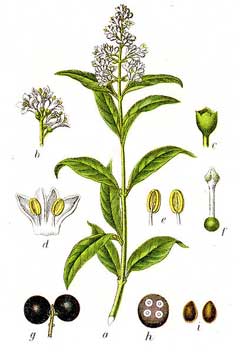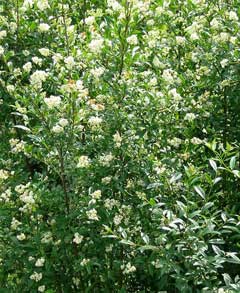 |
|
http://commons.wikimedia.org/wiki/File:Ligustrum_vulgare_Sturm1.jpg |
 |
| http://de.wikipedia.org/wiki/Benutzer:Mussklprozz |
Translate this page:
Summary
Bloom Color: White. Main Bloom Time: Early summer, Early spring, Late summer, Late spring, Mid summer, Mid spring. Form: Vase.
Physical Characteristics

 Ligustrum vulgare is an evergreen Shrub growing to 3 m (9ft) by 3 m (9ft) at a medium rate.
Ligustrum vulgare is an evergreen Shrub growing to 3 m (9ft) by 3 m (9ft) at a medium rate.
See above for USDA hardiness. It is hardy to UK zone 4 and is not frost tender. It is in leaf all year, in flower from June to July, and the seeds ripen from September to October. The species is hermaphrodite (has both male and female organs) and is pollinated by Insects.
It is noted for attracting wildlife.
Suitable for: light (sandy), medium (loamy) and heavy (clay) soils and can grow in heavy clay soil. Suitable pH: mildly acid, neutral and basic (mildly alkaline) soils and can grow in very alkaline soils.
It can grow in semi-shade (light woodland) or no shade. It prefers dry or moist soil and can tolerate drought. The plant can tolerate maritime exposure.
It can tolerate atmospheric pollution.
UK Hardiness Map
US Hardiness Map
Synonyms
Plant Habitats
Woodland Garden Sunny Edge; Dappled Shade; Hedgerow;
Edible Uses
References More on Edible Uses
Medicinal Uses
Plants For A Future can not take any responsibility for any adverse effects from the use of plants. Always seek advice from a professional before using a plant medicinally.
Astringent Bitter Detergent Vulnerary
The leaves are astringent, bitter, detergent, vulnerary[7, 21]. Internal use of this plant should be avoided since it can produce allergic symptoms[7]. Externally it is a safe and effective treatment[7]. The bark has been used as a stomachic[7], though this is not really recommended.
References More on Medicinal Uses
The Bookshop: Edible Plant Books
Our Latest books on Perennial Plants For Food Forests and Permaculture Gardens in paperback or digital formats.

Edible Tropical Plants
Food Forest Plants for Hotter Conditions: 250+ Plants For Tropical Food Forests & Permaculture Gardens.
More

Edible Temperate Plants
Plants for Your Food Forest: 500 Plants for Temperate Food Forests & Permaculture Gardens.
More

More Books
PFAF have eight books available in paperback and digital formats. Browse the shop for more information.
Shop Now
Other Uses
Basketry Charcoal Dye Ink Wood
A yellow dye is obtained from the leaves[6], from the bark, according to other reports[46, 61]. A bluish-green dye is obtained from the berries[6, 46, 61]; it is more permanent than most greens[115]. A black dye can also be obtained from the fruit[61] and an ink[46, 61]. Wood - hard, close-grained. It is valuable for turning if it reaches sufficient size[115] and can also make small tools[46, 61]. The wood is a source of charcoal[46, 61]. The young twigs are used in basketry and hurdle making[46, 61, 100]. Landscape Uses Border, Hedge, Screen, Superior hedge. Naturalizing, Attractive flowers or blooms.
Special Uses
Attracts Wildlife
References More on Other Uses
Cultivation details
A very tolerant and easily grown plant, it succeeds in any soil that is not very impoverished[11]. Grows well in heavy clay soils. Prefers a calcareous soil and succeeds in thin dry soils[186]. Grows well in light woodland or the full shade of a wall but flowers and fruits best in a sunny position[186]. Tolerant of atmospheric pollution, once established they also tolerate drought but are intolerant of water-logging[186]. A suckering shrub, forming dense thickets and making good bird cover[186]. An important food plant for many caterpillars, including the larvae of the privet hawk moth[186]. This species is notably susceptible to honey fungus[200]. Special Features:Not North American native, Invasive, Naturalizing, Attractive flowers or blooms.
References Carbon Farming Information and Carbon Sequestration Information
Temperature Converter
Type a value in the Celsius field to convert the value to Fahrenheit:
Fahrenheit:
The PFAF Bookshop
Plants For A Future have a number of books available in paperback and digital form. Book titles include Edible Plants, Edible Perennials, Edible Trees,Edible Shrubs, Woodland Gardening, and Temperate Food Forest Plants. Our new book is Food Forest Plants For Hotter Conditions (Tropical and Sub-Tropical).
Shop Now
Plant Propagation
Sow the seed in spring in a cold frame. Stored seed germinates better if it is stratified,[113]. Remove any fruit flesh from around the seed before it is sown since this can inhibit germination[113]. When they are large enough to handle, prick the seedlings out into individual pots and grow them on in the cold frame for their first winter. Plant them out into their permanent positions in late spring or early summer, after the last expected frosts. The seed can also be sown in outdoor seed beds in the autumn. You can leave the plants to grow on in the seedbed for up to 4 years before planting them out into their permanent positions in the winter. Cuttings of half-ripe wood, 5 - 10cm with a heel, July/August in a frame. Very easy[78]. Cuttings of mature wood, 20 - 30cm in a sheltered outdoor bed in November/December[78]. The cuttings can also be placed in situ if required. High percentage[78].
Other Names
If available other names are mentioned here
Native Range
TEMPERATE ASIA: Iran (northwest), Turkey, Russian Federation-Ciscaucasia (Ciscaucasia), Armenia, Azerbaijan, Georgia EUROPE: United Kingdom, Ireland, Norway (southeast), Sweden (southwest), Czechoslovakia, Austria, Belgium, Switzerland, Germany, Hungary, Netherlands, Poland, Moldova, Ukraine (incl. Krym), Former Yugoslavia, Albania, Bulgaria, Greece, Italy, Romania, Spain, France, Portugal AFRICA: Morocco
Weed Potential
Right plant wrong place. We are currently updating this section.
Please note that a plant may be invasive in one area but may not in your area so it's worth checking.
Conservation Status
IUCN Red List of Threatened Plants Status :

Growth: S = slow M = medium F = fast. Soil: L = light (sandy) M = medium H = heavy (clay). pH: A = acid N = neutral B = basic (alkaline). Shade: F = full shade S = semi-shade N = no shade. Moisture: D = dry M = Moist We = wet Wa = water.
Now available:
Food Forest Plants for Mediterranean Conditions
350+ Perennial Plants For Mediterranean and Drier Food Forests and Permaculture Gardens.
[Paperback and eBook]
This is the third in Plants For A Future's series of plant guides for food forests tailored to
specific climate zones. Following volumes on temperate and tropical ecosystems, this book focuses
on species suited to Mediterranean conditions—regions with hot, dry summers and cool, wet winters,
often facing the added challenge of climate change.
Read More
Expert comment
Author
L.
Botanical References
1117200
Links / References
For a list of references used on this page please go here
Readers comment
© 2010, Plants For A Future. Plants For A Future is a charitable company limited by guarantee, registered in England and Wales. Charity No. 1057719, Company No. 3204567.